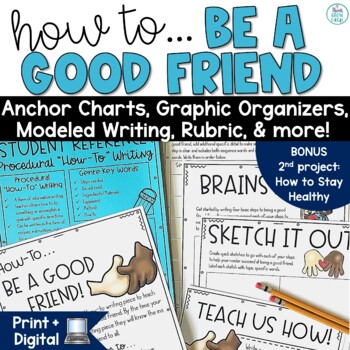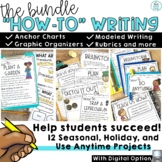How to Be a Good Friend Writing Prompt
- Zip
Also included in
- Are you looking for procedural writing activities to use in the classroom or during times of distance learning through Google Classroom™?Help your students master the skill of writing a how-to procedural writing piece to teach others how to do a variety of things that the students are experts at. ThPrice $31.00Original Price $60.50Save $29.50
Description
Are you looking for how to writing activities on how-to-be a good friend activity? These procedural writing organizers, activities, and step-by-step approach will help your students succeed. Your students will love teaching others how to stay healthy and how to be a good friend with the two projects included in this writing pack.
This pack includes 2 complete sets, perfect for back-to-school season:
- How to Be a Good Friend
- How to Stay Healthy
This procedural writing project includes everything you need to introduce, review, and enjoy procedural how-to writing: anchor charts, modeled writing, guiding questions, graphic organizers, rubric, and much more!
Grab the Procedural Writing Bundle to Save BIG HERE!
Anchor charts and modeled writing are also included in a PowerPoint presentation so that you can use them to guide your instruction.
Bulletin board letters and student writing and illustration pages are included to help you display your students' work on bulletin boards easily!
This product includes both printable and a Google Slide version.
CONTENTS:
✓Link for Google Slide use and digital directions
ANCHOR CHARTS:
✓What is Procedural/How To Writing?
✓What are Procedural/How To Key Words?
✓What are Sequential Key Words?
✓What are Other Helpful Words?
✓Procedural/How To Writing Organization
✓Who Is Your Audience?
✓What Are Procedural/How To Writing Tips?
✓Powerpoint Slide Show of Anchor Charts and Modeled Writing
✓Modeled Procedural/How To Writing Essay and Discussion Questions
✓Student Project Task Directions
✓Brainstorming and Planning Graphic Organizers
✓Sketching Page
✓Prompt Page (How to Stay Healthy and How to Be a Good Friend)
✓Student Editing and Revising Checklist
✓Teacher Rubric
✓Bulletin Board Letters (3 different phrases included) & Final Copy Paper Options
✓Teacher Suggestions
Teachers like YOU love these procedural writing packs because:
- they include genre-specific anchor charts
- the easy to follow rubric helps you to assess students
- the included student organizers and checklists guide students through the process
- this pack saves time planning
- student writing pieces come out amazing
Please see the preview for a closer look at all this product has to offer!
You will also love:
- Biography Research Project
- Endangered Animals Research Project
- Ocean Animals Research Project
- Year Long Poetry Writing
- Writing About Reading: Literary Essays
Follow me HERE for notifications of new products and sales. Remember new products are always 50% off the first 24 hours!
Questions? Email me directly HERE.






